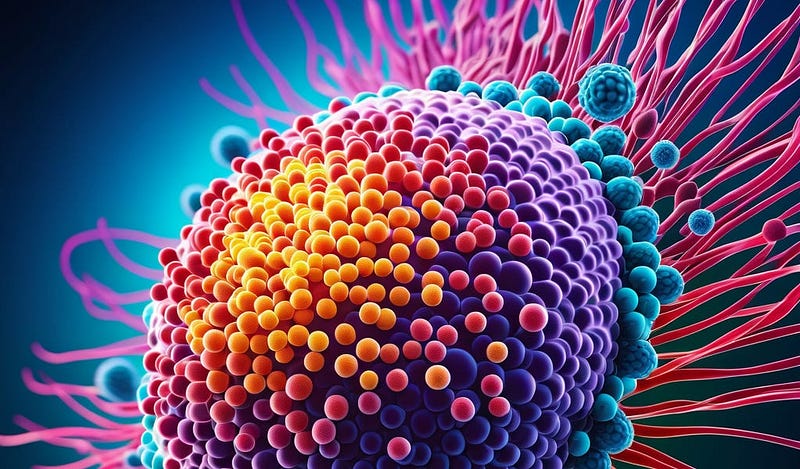Innovative Advances in Cancer Immunotherapy: A Dual-Action Approach
Written on
Chapter 1: The Promise of PD-1 Inhibitors
Recent advancements in cancer treatment have highlighted the role of PD-1 inhibitors, which are revolutionary in the field of immunotherapy. These drugs function by blocking the PD-1 checkpoint protein, a mechanism that cancer cells utilize to escape immune detection. By inhibiting this protein, the immune system is empowered to identify and attack cancer cells more effectively. This strategy has shown remarkable success across various cancer types, providing renewed hope for patients facing previously untreatable conditions. Notably, PD-1 inhibitors present a lower toxicity profile compared to conventional chemotherapy, positioning them as a transformative option in cancer care and sparking further research into additional immunotherapy strategies.
While many patients benefit from immunotherapy, responses can vary significantly. To address this, researchers have been focused on enhancing the effectiveness and applicability of these therapies. A recent investigation introduced a promising small-molecule drug candidate, now in early clinical trials, aimed at improving patient reactions to immunotherapy. This study indicates that the molecule operates via dual mechanisms, effectively slowing tumor growth and extending survival in lab tests.
Researchers from the Tumor Immunotherapy Discovery Engine (TIDE) at the Broad Institute of MIT and Harvard, in collaboration with AbbVie and Calico Life Sciences, have demonstrated that this innovative molecule can inhibit tumor growth while simultaneously boosting the immune system's response to cancer. It uniquely targets two proteins, PTPN2 and PTPN1, which typically instruct cells to ignore activation signals for immune cells.

"This collaboration among Calico, the Broad Institute, and AbbVie exemplifies the synergy of academic and industrial expertise, enabling the swift translation of early biological insights into a clinical candidate—the first known active site phosphatase inhibitor of its kind,"
~ Marcia Paddock, Co-author of the Study
Chapter 2: Mechanisms of Action
When this molecule inhibits PTPN2 and PTPN1, immune cells such as T and NK cells become more adept at destroying tumor cells, while also rendering the tumor cells more vulnerable to attacks. Furthermore, this inhibition lessens “T-cell exhaustion,” a condition that can hinder the effectiveness of cancer immunotherapy.
The unique aspect of this molecule is its ability to act on both tumor cells and immune cells simultaneously, distinguishing it from traditional cancer immunotherapy drugs like PD-1 inhibitors. Researchers believe that this dual-action capability may allow the molecule, named ABBV-CLS-484, to function effectively on its own without needing to be paired with other treatments, such as anti-PD-1 therapy.

A significant breakthrough occurred in 2017, which laid the groundwork for TIDE’s current research. Many team members analyzed nearly 2,400 genes related to cancer in murine models, striving to identify which genes influenced melanoma tumor responses to PD-1 inhibitors. Their research focused on PTPN2, and they found that its deletion significantly improved tumor responsiveness to anti-PD-1 therapy. Notably, PTPN2 is abundant in T cells, a critical component of the immune system.
Previous findings have indicated that the removal of PTPN2 could enhance the activation of T cells, empowering them to combat tumors more effectively. Both PTPN2 and its counterpart PTPN1 code for proteins that inhibit an essential immune pathway known as JAK-STAT. However, developing drugs to inhibit these proteins has been challenging due to their strong electric charges, complicating the entry of such drugs into cells.
AbbVie researchers overcame this hurdle by creating a small molecule that can penetrate cells and bind to PTPN2 and PTPN1. Animal studies yielded promising results, showing that treated mice experienced slower tumor progression and increased survival rates compared to untreated counterparts, suggesting that ABBV-CLS-484 may be effective on its own, a departure from many other emerging immunotherapies.

Furthermore, when mice received both this new molecule and an anti-PD-1 drug, the results were even more favorable, indicating that ABBV-CLS-484 could complement existing immunotherapies in patients. Researchers uncovered the underlying reason for the drug's effectiveness in laboratory animals: blocking PTPN2 and PTPN1 made tumor cells more receptive to immune attack signals. Additionally, the drug enhanced the activity of natural killer (NK) cells and T cells, both essential for fighting cancer, in animal tumors and human blood samples.
Notably, ABBV-CLS-484 seems to prevent T-cell exhaustion. Even in challenging environments, such as tumors lacking immune cells or cancers that have metastasized, T cells treated with this molecule continued to thrive and proliferate. This is attributed to the drug's enhancement of the JAK-STAT signaling pathway, which maintains T-cell activity and staves off exhaustion. This pronounced effect on T cells is unique and has not been observed with other immunotherapies, including anti-PD-1 treatments.
Researchers at TIDE are partnering with AbbVie, Calico, and various organizations to design a new series of clinical trials aimed at identifying biomarkers that can predict patient responses to ABBV-CLS-484. Comprehensive findings are available in the Journal of Nature.
The first video, "Current Trends in Cancer Immunotherapy with A Focus on Cytokine Therapies," discusses the latest advancements in immunotherapy and highlights the potential of cytokine therapies in enhancing immune responses against cancer.
The second video, "Immunotherapy: Boosting the Immune System to Fight Cancer," explores how immunotherapy can enhance the body's immune response to combat cancer more effectively.
Stay informed with the content that matters — Join my Mailing List.